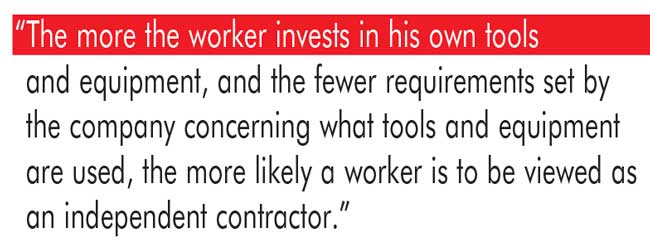
Are you at risk for a claim that a worker has been misclassified? As Macy’s learned the expensive way, contracting out the work to a third party does not insulate you from liability.
You’ve probably seen it in the news – across the country, delivery drivers have asserted lawsuits alleging that they are employees of the companies they are making deliveries for and have been misclassified as independent contractors. These lawsuits have been brought against Macy’s, Sleepy’s, Amazon, Federal Express and others.
Maybe your company doesn’t make deliveries. Maybe you’ve hired a third party company to handle deliveries for you. Or maybe you even classify your drivers as employees rather than independent contractors. So, you’re in the clear, right? Well, maybe not. If there is anyone who does work for your company and is paid as an independent contractor (which is generally reported on a tax Form 1099), you’re at risk for a claim that the worker has been misclassified. And as Macy’s learned the expensive way, contracting out the work to a third party does not necessarily insulate you from liability.
The U.S. Department of Labor believes that “the misclassification of employees as independent contractors presents one of the most serious problems facing affected workers, employers and the entire economy.” The Internal Revenue Service estimates that employers mis-classify millions of workers as independent contractors. The government is focused on this issue, which means that companies should be as well.
Independent Contractors Cost Less... Until They Don’t
There are certainly financial and other benefits to a company in classifying workers as independent contractors rather than employees. Independent contractors are not entitled to minimum wage or overtime. They cannot claim unemployment or workers’ compensation benefits. They are not entitled to protected leave or other employer benefits. And a company does not have to pay or deduct any payroll taxes for the worker. So, a company may save money by classifying a worker as an independent contractor, but the costs of misclassification are high.
The issue of whether an employee has been misclassified can arise in many different ways. Sometimes, it is the worker himself who raises the issue. Workers often prefer to be paid as independent contractors. But even if they agree to the arrangement initially, they may change their mind down the road if their self-interests change. Perhaps they’ve worked more hours than they anticipated and want to be paid overtime. Maybe they’ve been subjected to harassing conduct and want to pursue a lawsuit for a hostile work environment. If an employee is injured at work, he might file for workers’ compensation benefits not even realizing that this will raise a misclassification issue for the company. Or once the relationship ends, the worker may file for unemployment insurance benefits.

Even if a worker never questions his status, there are several government agencies that might. As expressed by the DOL, “Employee misclassification generates substantial losses to the federal government and state governments in the form of lower tax revenues, as well as to state unemployment insurance and workers’ compensation funds.” This loss of money has gotten the government’s attention. The DOL has entered into partnerships with the IRS and with 35 states “to combat employee misclassification... through, for example, information sharing and coordinated enforcement.” According to the DOL, “in Fiscal Year 2015, [its] investigations resulted in more than $74 million in back wages for more than 102,000 workers.” The government does not require an employee complaint in order to conduct an audit. So, on any day of the week, the federal or state government can show up at your door and require you to turn over records relating to all “1099” workers to review whether any of them appears to be a misclassified employee. It’s important for you to be prepared for that day.
Misclassification can result in back taxes, with penalties and interest. An employer who has misclassified a worker will be subject to a penalty of 1.5% of wages paid to the employee, plus 20% of the amount that should have been withheld for Social Security and Medicare tax from the employee, plus 100% of the employer’s share of Social Security and Medicare tax. If the IRS suspects intentional misconduct, it can impose additional fines and penalties. State laws may also impose additional penalties. The worker at issue may also be entitled to economic damages, including unpaid minimum wages and overtime, plus interest, 100% liquidated damages and attorneys’ fees. If there are a group of misclassified workers in the same or similar position, you may also be at high risk for a costly and time-consuming class action lawsuit. And, of course, don’t forget the cost of hiring your own attorney to battle or resolve the matter, even if you’re ultimately successful.
Class Actions Against Macy’s
Last year, Macy’s settled two independent contractor misclassification class actions brought by delivery drivers and their helpers. In both cases, Macy’s had contracted with logistic providers to execute the deliveries. But, in both cases, the plaintiffs alleged that they were actually Macy’s employees because they were under Macy’s control. The workers claimed that they were “heavily regulated” by Macy’s, including being hired by Macy’s employees, being required to install Macy’s banners on their trucks, being required to wear Macy’s uniforms and conform with certain appearance standards, being required to follow a delivery schedule set by Macy’s, and being required to announce themselves to Macy’s customers as “Macy’s delivery” and “from Macy’s.” After years of litigation, Macy’s and its logistic providers settled the two class actions for $6.8 million, with Macy’s paying the bulk of the settlement amount.
Macy’s experience does not suggest that delivery workers cannot be independent contractors or that a relationship with a logistics provider cannot help to insulate a company from risk. In the end, it all comes down to control. Macy’s maintained significant control over the delivery workers at issue, which created significant risk that a court would consider them to be Macy’s employees and, in the end a significant cost, for Macy’s.
Employee or Contractor?
There are circumstances where it is appropriate to utilize independent contractors to perform services for your company. What’s important is that you are confident in the classification and are able to support it if challenged. Accordingly, you want to conduct a review of your independent contractor classifications before anyone else does it for you.

Ideally, there would be one set of factors you could consider in analyzing whether a worker is an independent contractor or employee. There is not. The IRS test is different than the DOL test, which is different than the National Labor Relations Board test, which is different than a multitude of state law tests for unemployment and workers’ compensation, and so on. While each law requires a different review, there is overlap between them. Who ultimately directs and controls the work is a critical inquiry of all independent contractor analyses, as well as how central the work is to the employer’s business and whether the worker is truly in business for himself. Accordingly, as a starting point in a company’s review of its independent contractors, it must consider:
- How much control and direction does the company exercise over the worker? The less control and supervision the company exercises (e.g., what work is done, how it is done, when and where the work is performed, amount of supervision, etc.), the less likely the company is to be viewed as the worker’s employer.
- Does the company provide the tools and equipment necessary for the work? The more the worker invests in his own tools and equipment, and the fewer requirements set by the company concerning what tools and equipment are used, the more likely a worker is to be viewed as an independent contractor.
- Is the work being performed a key aspect of the company’s business? If a worker provides services that are a key aspect of the company’s regular business activity, it is more likely that the company will have the right, and need, to direct and control the worker’s activities. According to the DOL, “work is integral to the employer’s business if it is a part of its production process or if it is a service that the employer is in business to provide.”
- Is the worker economically dependent on the company? While certainly not determinative, a worker with an independent business who performs work for a number of different companies is more likely to work independently and, thus, more likely to be viewed as an independent contractor. Questions that may arise include: Does the worker have his own website? His own business cards? Will he have 1099s from multiple companies for the same time period?
- Does the worker have an opportunity for profit or loss? Workers who can make decisions to hire others, purchase materials and equipment, advertise, rent space, and manage their own time may be able to affect their opportunity for profit or loss and be more likely to be considered an independent contractor.
- What is the duration of the relationship? Permanency or indefiniteness in a worker’s relationship with the employer suggests that the worker is an employee.
No one of these factors will be determinative and any other relevant factors will also be considered in determining the overall picture of a company’s control over an economic relationship with its worker. Having an agreement with a worker that calls him an independent contractor may be considered, but will certainly not control.
While analyzing a worker’s status as independent contractor or employee may not be simple, it is a critical step to avoid the costly mistake of misclassification. Companies unfamiliar with the independent contractor tests or with borderline cases may want to consider consulting an attorney to assist with the review.
About Sara Kula: Sara Kula is the head of the Employment Law group at DelBello Donnellan Weingarten Wise & Wiederkehr, LLP. She represents businesses in all aspects of the employment relationship, with an emphasis on: Wage and hour compliance; Workplace harassment and discrimination; Leaves of absence and disability accommodations; Neutral investigations of work-place complaints; Single plaintiff and class-action litigation; and Administrative audits and complaints.
Sara counsels clients to ensure compliance with federal, state and local laws, provides guidance when questions arise on hiring, performance management, terminations, workplace disputes, or other issues, and defends businesses before federal and state courts and administrative agencies. She also regularly drafts handbooks, policies, and employment-related agreements. As former in-house counsel, Sara views matters with a business-oriented mindset and looks for effective, low-cost and operationally efficient solutions. She also conducts mediations and workplace investigations.
For more information on employment law issues affecting furniture retailers or manufacturers, contact Sara Kula at
sdk@ddw-law.com, Phone: 914-681-0200, ext. 133.
Furniture World is the oldest, continuously published trade publication in the United States. It is published for the benefit of furniture retail executives. Print circulation of 20,000 is directed primarily to furniture retailers in the US and Canada. In 1970, the magazine established and endowed the Bernice Bienenstock Furniture Library (www.furniturelibrary.com) in High Point, NC, now a public foundation containing more than 5,000 books on furniture and design dating from 1620. For more information contact editor@furninfo.com.